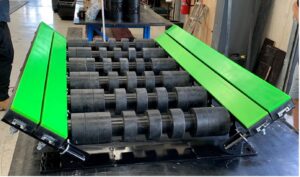How to Identify a Quality Roller for a Conveyor System?
On a conveyor system, your rollers are one of the most hard-working components. Rollers come in many varieties, shapes, sizes and materials. You’ll often be making choices about your rollers based on many factors, including the type of plant you have (fixed / mobile etc), the materials you are handling, any technologies you require integrated and price. No matter what your requirements, there are some fundamental features you should be looking for when you purchase replacement rollers for your conveyor system.
Types of Rollers
Before we explore what to look for, its important to establish a baseline on the various types of conveyor rollers that are utilised in the mining and quarry industries. These rollers can be made in many different materials, including a range of steel and/or alloy rollers, various polymer (poly) rollers or combinations of the two.
Below are the common types of rollers used, across both fixed plant and mobile equipment.
Troughing rollers / idlers:
Troughing idlers are essential for supporting the belt and transporting material on the conveyor. They create a trough shape, allowing for efficient material containment and preventing spillage. In fixed plant, often all rollers that make up the frame are the same dimensions.
Centre rollers:
The centre roller is typically the bottom of the trough. Centre rollers can be made of various dimensions, although as stated, can often be the same as the troughing roller, particularly on fixed plant.
Wing Rollers:
A wing roller is a term typically given to the rollers utilised on mobile equipment. The wing rollers are like trough rollers, in that they form trough shape in the belt, however they normally have in built brackets that allow the roller to be installed without a frame. Their frameless design provides a blend of performance but with some trade-offs to keep weight down on the machine.
Impact rollers / idlers:
These rollers are designed with impact absorbing materials and / or additions, such as rubber discs and shock-absorbers. These speciality rollers are positioned to absorb the impact of heavy, falling materials, these rollers prevent damage to the conveyor belt and extend its lifespan.
Return rollers / idlers:
Placed on the underside of the conveyor belt, return rollers support the belts return journey, maintaining proper belt tension and alignment.
Weigh rollers:
These speciality rollers are utilised in conveyor belt weighing systems. These rollers are designed with accuracy in mind, as they typically support the recording of material flow rates and allow monitoring of production.
Physical Inspections and Checks
When purchasing replacement rollers for your conveyor system, there are a number of important factors to consider. Many of these factors are remain relevant when conducting preventative maintenance inspections on your existing rollers to ensure you can maximise their lifespan.
Material Quality:
High-quality rollers are constructed from robust materials like steel or alloys, capable of withstanding harsh conditions. A visual inspection verifies the roller’s material composition. Often confirming the weight of your roller can be enlightening, particularly on fixed plant. Heavy can often mean stronger materials have been utilised. This factor is less important on mobile plant, but a comparison of the materials utilised on your replacement roller is critical to assessing quality.
Bearing Quality:
One of the first inspections we conduct in assessing a quality roller is to check their bearings. Rollers rely on durable, sealed bearings. The bearing should typically spin freely in your hand, with the shaft spinning at both ends. This inspection is also important when conducting preventative maintenance. Inspecting for signs of wear, corrosion, or damage ensures the roller’s efficiency and longevity.
Shaft Integrity:
A straight and robust shaft is crucial for proper roller functioning. Inspecting the shaft for bending, warping, or damage is essential. In some cheaply made rollers, often the shaft may not even run completely through the entirety of the roller. Conducting the check above will ensure this is not the case for your replacement roller.
Sealing Mechanism:
Effective sealing mechanisms protect rollers from fines, moisture, and abrasives. A large majority of roller failures come from the bearings being impacted by moisture and other contaminants. A good seal is typically designed to help spin out fines and other contaminates. Inspecting seals ensures environmental factors don’t compromise roller functionality.
Conclusion
Poor quality roller selection can cost you significant time and money. Once a roller fails, quite often that roller will commence placing undue wear on your conveyor belt. In catastrophic fails, particularly where the roller begins to come apart, the roller can act as a knife, shredding your conveyor belt requiring a repair or total belt change out. While there are plenty of rollers on offer in the market, finding a quality roller is critical. At Australian Crushing & Belting Group, we are specialists at material handling. We know what to look for in a quality roller, and only supply that which meets our stringent standards. All our rollers are field tested in some of the harshest conditions. If you have questions about the performance of your current conveyor rollers, give us a call and see if we can help.






